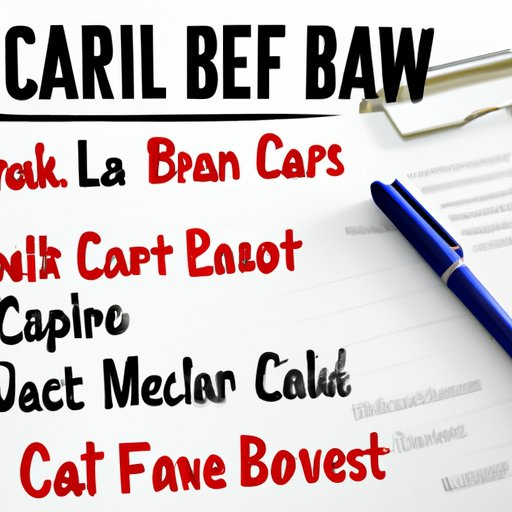Introduction
A low-carb diet is an eating plan that limits carbohydrates, such as those found in sugary foods, pasta, and bread. It’s high in protein, fat, and healthy vegetables. Many types of low-carb diets exist. Each diet has varying restrictions on the types and amounts of carbohydrates you can eat.
Proponents of low-carb diets say that reducing carbs lowers insulin levels, which causes the body to burn stored fat for energy and ultimately leads to weight loss. Research suggests that a moderate-carbohydrate diet may be the best approach for long-term health.
Explaining the Basics of a Low-Carb Diet
If you’re considering trying a low-carb diet, it’s important to understand what foods to include in your diet, how many carbs to eat, and what foods to avoid.
What Foods to Eat
On a low-carb diet, you should focus on eating lean proteins, healthy fats, and low-carb vegetables. Here are some foods to include in your diet:
- Meat, fish, and poultry
- Eggs
- Non-starchy vegetables, such as spinach, kale, and broccoli
- Healthy fats, such as avocado, olive oil, and coconut oil
- Nuts and seeds
- Full-fat dairy products, such as cheese and yogurt
How Many Carbs to Eat
The number of carbs you should eat depends on your individual needs and preferences. Generally, most people aim for between 20–50 grams of carbs per day for weight loss. Some people may need to go lower than this if they want to see results. Your doctor can help you determine the right amount of carbs for your body.
Sample Meal Plans on a Low-Carb Diet
Following a low-carb diet doesn’t mean you have to give up all your favorite foods. With a little creativity, you can come up with delicious meals that fit into your diet. Here are some sample meals to get you started.
Breakfast
Start your day off with a healthy breakfast. Try scrambled eggs with smoked salmon, feta, and roasted vegetables or a frittata with tomatoes, spinach, and mozzarella.
Lunch
For lunch, try a salad made with grilled chicken, spinach, tomatoes, cucumbers, and nuts. Or try a turkey wrap with lettuce, tomato, and avocado.
Dinner
End your day with a hearty dinner. Try grilled salmon with broccoli and cauliflower rice or a turkey burger with lettuce and tomato on a bed of greens.
Common Mistakes People Make When Starting a Low-Carb Diet
When starting a low-carb diet, it’s important to be mindful of some common mistakes people make. Here are a few things to watch out for:
Not Eating Enough Protein
Many people on low-carb diets don’t eat enough protein. Protein helps keep you feeling full and can help preserve muscle mass during weight loss. Aim to get at least 0.8–1 gram of protein per kilogram of body weight each day.
Eating Too Many Processed Foods
It’s easy to fall into the trap of eating processed, low-carb foods, such as bars, shakes, and frozen meals. While these foods can be convenient, they aren’t always the healthiest option. Try to stick to whole, unprocessed foods whenever possible.
Not Reading Nutrition Labels
Reading nutrition labels is key when following a low-carb diet. Many processed foods contain hidden sugars and other carbs. Read the labels carefully and opt for foods that are lower in carbs.
Tips for Making a Low-Carb Diet Easier to Follow
Making changes to your diet can be challenging. Here are some tips to make it a bit easier:
Prepare Meals Ahead of Time
Meal prepping can help save time and make it easier to stick to your diet. Cook several servings of your favorite low-carb meals and store them in the fridge or freezer for easy access.
Find Low-Carb Alternatives
There are plenty of low-carb alternatives to your favorite high-carb foods. For example, try using zucchini noodles instead of traditional pasta or cauliflower rice instead of regular rice.
Don’t Be Afraid to Experiment
Be creative and experiment with different flavors and ingredients. Try new recipes and find dishes that you enjoy. This will keep your meals interesting and make it more likely that you’ll stick to your diet.
Conclusion
A low-carb diet is an eating plan that limits carbohydrates, such as those found in sugary foods, pasta, and bread. It’s high in protein, fat, and healthy vegetables. Many types of low-carb diets exist, and the amount of carbs you should eat depends on your individual needs and preferences.
When following a low-carb diet, it’s important to focus on eating lean proteins, healthy fats, and low-carb vegetables. It’s also important to read nutrition labels and watch out for hidden sugars and carbs. To make it easier to stick to your diet, prepare meals ahead of time, find low-carb alternatives, and don’t be afraid to experiment with new recipes.
Research suggests that a moderate-carbohydrate diet may be the best approach for long-term health. However, a low-carb diet can be beneficial for short-term weight loss and improved blood sugar control. Talk to your doctor before starting any diet to make sure it’s safe for you.
(Note: Is this article not meeting your expectations? Do you have knowledge or insights to share? Unlock new opportunities and expand your reach by joining our authors team. Click Registration to join us and share your expertise with our readers.)
